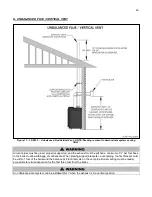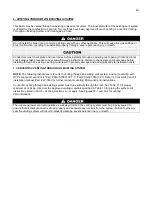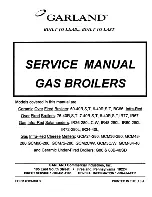
31
MINIMUM PIPE SIZES
EL 80, EL 110, EL 150, EL 220
1” NPT or Copper
EL 299
1 ¼” NPT or Copper
EL 399
1 ½” NPT or Copper
Table 7
K. FILL AND PURGE HEATING SYSTEM
1. Attach the hose to balance and purge hose connector or drain valve and run hose to nearest drain.
2. Close the other side of the balance and purge valve or shut off valve after the drain.
3. Open the first zone balance and purge or drain valve to let water flow out of the hose. If zone valves are used,
open the valves one at a time manually. NOTE: You should check zone valve manufacturer’s instructions prior to
opening valves manually, so as not to damage the zone valve.
4. Manually operate fill valve regulator. When water runs out of the hose, you will see a steady stream without
bubbles. Close the balance and purge valve or drain to stop the water from flowing. Disconnect the hose and
connect it to next zone to be purged.
5. Repeat this procedure for additional zones (one at a time).
For installations that incorporate standing iron radiation and systems with manual vents at the high points, follow
the previous section and, starting with the nearest manual air vent, open the vent until water flows out. Then close
the vent. Repeat the procedure, working your way toward the furthest air vent. It may be necessary to install a
basket strainer in an older system where larger amounts of sediment may be present. Annual cleaning of the
strainer may be necessary.
Upon completion, make sure that the fill valve and zone valves are in automatic positions. You must also assure
the purge and shut off valves are in open positions.
L. GLYCOL ANTIFREEZE SOLUTIONS
Use only inhibited propylene glycol solutions which are specially formulated for hydronic systems. Ethylene glycol
is toxic and can attack gaskets and seals used in hydronic systems. Glycol mixtures should not exceed 50%.
Glycol in hydronic applications should include inhibitors that prevent the glycol from attacking metallic
system components. Make certain that the system fluid is checked for the correct glycol concentration
and inhibitor level.
The glycol solution should be tested at least once a year or as recommended by the glycol manufacturer.
Anti-freeze solutions expand more than water. For example: A 50% by volume solution expands 4.8% in
volume for a temperature increase from 32
o
F to 180
o
F, while water expands 3% over the same
temperature rise. Allowances must be made in system design for expansion.
A 30% mixture of glycol will result in a BTU output loss of 15% with a 5% increase in head against the
system circulator.
A 50% mixture of glycol will result in a BTU output loss of 30% with a 50% increase in head against the
system circulator.
Summary of Contents for EL-110
Page 15: ...15 Figure 3 ...
Page 61: ...61 Figure 29 ...
Page 62: ...62 Figure 30 ...
Page 87: ...87 Figure 33 ...
Page 88: ...88 Figure 34 ...
Page 89: ...89 Figure 35 LP 293 A NOTE Parts listed on the following page ...
Page 94: ...94 ...
Page 95: ...95 ...
Page 96: ...96 MAINTENANCE NOTES ...
















































